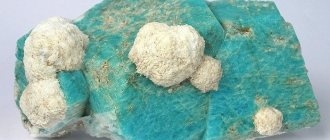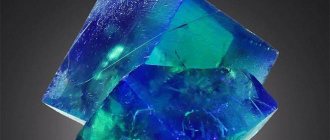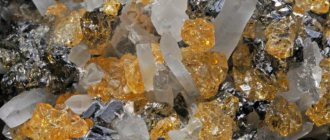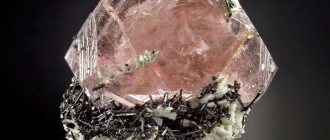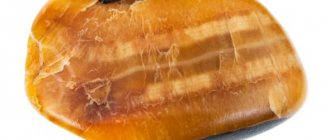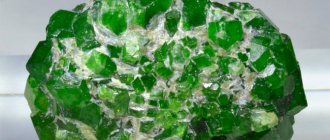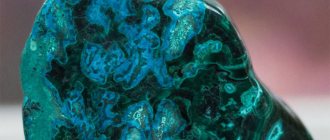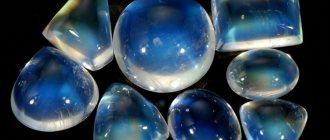Origin story
This stone is not often found in nature. Related to semi-precious gems. The history of the breed is surrounded by mystery and mystery. The name comes from the word “soda”, which means sodium in English. Or Sodium - from the Greek "lotus". Natural stone has other names - Alomite and Hakmanite.
The mineral sodalite was named by Thomson in 1810. There is no mention of the stone either in medieval or earlier literature. He became famous not so long ago. Sodalite is a chlorinated sodium aluminosilicate.
Its rarity in nature is due to the fact that the gem is extracted from alkaline volcanic rocks and pegmatites. It can be found in metasomatically reworked limestones in the zone of their contact with intrusions of nepheline syenites. Found in meteorites.
Areas of application of the mineral
The stone is often used in jewelry. The mineral is classified as semi-precious. Fersman and Bauer included it in the same group with lapis lazuli, jade, malachite, aventurine, rose quartz, and jasper.
Various jewelry is made from sodalite: beads, bracelets, rings, earrings, etc. These are inexpensive products. For example, beads can be bought for 1,500 rubles.
The gem is also used for other purposes:
- In production as a catalyst that accelerates certain chemical reactions.
- In magic - they make amulets, talismans, amulets.
- In lithotherapy (stone therapy) to rid a person of diseases.
- For making decorative items. It makes interesting figurines, souvenirs, etc.
Physical properties
| Property | Description |
| Formula | 3Na2O•3Al2O3•6SiO2•2NaCl |
| Hardness | 5,5 — 6 |
| Density | 2.29 g/cm³ |
| singonia | Cubic |
| Kink | Rough or conchoidal |
| Cleavage | Implicit |
| Shine | Glassy or greasy |
| Transparency | Transparent or translucent |
| Color | Blue, white, pink, gray and green |
- Has the ability to absorb water vapor and volatile substances.
- Participates in ion exchange reactions.
- Can change color and follow the reverse process. Knowing this property, jewelers deliberately give dark stones a lighter tone. And colorless ones are enhanced to bright blue.
- It has the appearance of a greasy glass sheen.
- Can be processed with a file.
Chemical composition
Chemical theoretical composition of sodalite: Na2O- 25.60; Al2O3 - 31.60; SiO2 - 37.14; Cl - 7.31. The composition generally corresponds to the formula, fluctuations of the main components (wt.%): SiO2 - 37.88-36.5; Al2O3 - 32.2-30.43, Na2O - 25.95-21.74, K2O content can reach 4.13, and Fe2O3 - 3.52%. Sometimes it contains up to 2% CaO. Some analyzes indicate an insignificant content of CO2, SO3, MgO, B2O3, P2O5. The Cl content is generally constant - 6.1-7.3%. The content of sulfide sulfur in samples from the Lovozero massif (%): in poikilitic syenites 0.381 (Chinglusuay), in pegmatites 0.527 (Mount Karnasurt) and 0.699 (Mount Alluayv) [40]. Water is either absent, or in some analyzes up to 2-3% H2O is noted, but the numbers require verification, since in sodalite analyzes, taking into account the volatility of NaCl, only direct determination of water is permissible; In addition, due to the very common zeoligization of the mineral, some of the water may belong to secondary products. Minor amounts or sl. are also noted. Mn, Ga, Be, Zr, Ti, Cr, Cu, Ni, W, Sr, Li, P, Ba, Rb, Cs.
Variety of shades
The stone comes in different shades.
- Blue and light blue with white veins and dots,
- Yellow sodalites exist in nature,
- Greens,
- Grayish-blue hue.
Sodalites of red shades can change color to black when exposed to air. In honor of Victor Hackman, who discovered this reaction in 1903, this species is named Hackmanite. Under the influence of chemicals, black stones can be returned to their original color, and colorless minerals can be turned blue.
Photo gallery of stone coloring
Gem deposits and its varieties
The rare stone is found in volcanic rocks, pegmatites and aluminas in alkaline environments, hence the “soda” name. Sometimes it is found in workings of limestone rocks in contact with nifeline syenites.
Most of the finds have excellent aesthetic properties, therefore they are widely used in jewelry practice, although they are mined in small quantities. The main suppliers to the jewelry raw materials market:
- Italy (southern provinces and Sicily);
- Russian Federation (Kola Peninsula and Chukotka);
- Kenya (Africa);
- South America (Andes and Brazil).
India and Nepal do not supply the most brightly colored samples, so they are used to make rosaries and souvenirs. In the USA and Canada, Norway, the Czech Republic and Ukraine there are small deposits and ornamental samples.
Most common variations
It is not so common to see color variations in sodalite that have their own names. These are sodalite (classic blue with gray veins) and alomite (bright blue with blue and whitish streaks).
The most delightful variety is Hackmanite. It is distinguished by crimson and pinkish tints, with occasional orange inclusions.
The only drawback of hackmanite is that under prolonged exposure to ultraviolet rays it can lose its unique color and become paler. Therefore, it is better to wear a rare pink-raspberry amulet on the body, and not on top of clothes.
Are there fakes?
Sodalite is not such a popular, sought after or expensive mineral that it needs to be developed, produced or offered as an imitation. Rather, buyers will be misled and less valuable specimens will be sold as more expensive gems, such as lapis lazuli.
Attention! Certified goods and official points of sale – protection against counterfeiting at any level.
Sometimes it can be found in mixes - beads and bracelets made of multi-colored crystals. The bright color of this stone helps make the gray and green threads of simple women's jewelry more attractive.
When there is a suspicion that they are offering jewelry not made of stone, but of glass, you need to compare thermal conductivity. A natural mineral always takes longer to heat up from the heat of the hand than glass or polymer with dye.
Medicinal properties
The gem is able to protect against radioactive radiation. Lithotherapists use the stone in the treatment of diseases caused by radiation. In China, the gem is used to restore blood pressure by applying it to the head or placing it at the head of the bed.
The therapeutic effect affects the functioning of the organs of vision, liver, heart, blood vessels, kidneys, and digestive system.
The blue mineral eliminates nervousness and treats insomnia. Lithotherapists use the stone in the treatment of cancer patients and to eliminate infectious diseases. It is placed on the body, in the area where the diseased organ is located.
And looking at the stone for a long time prevents loss of vision. Sodalite has a positive effect on the functioning of the endocrine and lymphatic systems and normalizes metabolism. It has a powerful effect on the thyroid gland during inflammation, goiter, Graves' disease and strengthens bone tissue.
Crystallographic characteristics
Syngony . Cubic.
Symmetry class. Hexatetrahedral—43t.
Crystal structure
The structure was first deciphered by Pauling in 1930, and subsequently it was refined several times. The basis of the structure is a three-dimensional 1:1 framework with a completely ordered arrangement of Si, Al and O atoms, characterized by a cuboctahedral cell of 6- and 4-membered rings. According to this, it is possible to partially replace aluminum with ferric iron. Its cavities contain Na+ and Cl ions. Each Na ion located in the cavity of the 6-membered ring is located in the center of a trigonal pyramid, the vertices of which are occupied by three oxygen atoms and the Cl- ion. The Cl- anions are surrounded in a tetrahedron by four Na+ cations, forming [Na4Cl]3+ clusters, which are located at the vertices and center of the cubic unit cell. The hexagonal rings are somewhat distorted due to Na-Cl bonds: Na+ is shifted from the middle plane by 1.11 A towards Cl-; six O atoms are located at unequal distances from Na+ - 2.353 and 3.087 A. Si-O-Al angle = 138.2°. The ESR method revealed the presence of stable inorganic radicals SO4-, O2-, S) in the structure, as well as the oxygen ion O-. The study of the bridge ion O- (A1-0-A1) showed in some samples a partial disordered distribution of Al over two structural positions of Si. SO4- are located in the Cl position, and O2- molecular ions are located in nonequivalent structural positions that have the same symmetry but different crystal field values. The SO4 radical ion has the least stability and is completely destroyed at -350°, and the blue color of the stone disappears. Radicals S2- and O2 are stable up to 700°.
Main forms : Rhombododecahedra. In addition to the predominant faces (110), (100) and (211) develop, very rare (111), as well as (411). On the faces (110) there are triangular etching figures.
Magic properties
In magic, sodalite is perceived as a tool that develops supernatural abilities in a person.
Knowledgeable people use it for meditative work. Sodalite beads give great attractiveness to women, but not in terms of decoration. They begin to experience increased sympathy for a woman thanks to the energy of the stone. It helps men clearly and quickly navigate difficult decisions and puts their thoughts in order.
- Blue sodalite develops intuition. A person has 7 main chakras. The one that is responsible for vision and the thought process is located above the bridge of the nose and has a blue tint. Therefore, the mineral must be of the appropriate color.
- Yellow sodalite is suitable for achieving internal harmony and spiritual development.
- The red stone is responsible for restoring vitality. The chakra responsible for our health and activity is located in the perineum and has the same shade. The mineral assists in achieving existing goals and performs the function of protection from undesirable events.
- Yellow and red shades will help ensure self-confidence. Sodalite reduces the owner’s level of aggressiveness and helps establish contact with unfamiliar and close people.
Using gems in magic
The magical properties of sodalite stone have unlimited potential. He acts in magic as a talisman, as a guardian, as a mentor and in several other roles. If you are lucky enough to get a natural stone, then by all means use it in jewelry. Constantly wearing the stone attracts positive emotions, good luck and leaves no chance for bad mood and apathy. The magical effect of the gem occurs on the wearer on several levels at once:
- Spiritual (gives you the opportunity to take a sober look at the situation, learn to understand loved ones; look inside yourself and resolve internal conflicts);
- Physical (the mineral saturates the wearer with energy, an unstoppable will for great achievements and gives strength to create an ideal living space).
- Interpersonal (carriers of the stone often had thoughts that they had become objects of adoration of the opposite sex. This is true, because sodalite increases sexuality and gives maximum self-confidence).
Who is sodalite suitable for:
- It is definitely worth purchasing a sodalite stone for people whose work involves communication. Numerous interactions one way or another take away part of the vital energy. The mineral helps preserve energy potential and protect the owner from “energy vampirism.”
- Believers use stones for prayers. It is believed that he helps convey his words to heaven.
- The gem also has its own preferences regarding the owner. He will immediately reject fussy, petty people who throw words to the wind. But balanced, secretive and even modest people will find a good, kind ally in him.
The magical properties of the stone vary according to its color. For example, blue mineral beads strung on a thread will help the fair sex enhance femininity and find personal happiness. Light gems, from which various souvenir attributes are made, will help entrepreneurs and people with nervous work.
How to determine if a stone is right for you
There is an opinion, based on the experience of experts, that a certain stone is suitable for specific zodiac signs. But to generalize all Geminis like any other sign would be a mistake.
The character, behavior and perception of life are influenced by many factors - on what day and minute a person was born, in what family he was raised and what reactionary programs were invested by relatives and friends. For example, there are hard and softer Scorpios.
You can determine whether a stone is suitable for the owner using a pendulum. Before buying jewelry, place it on your palm, and with your other hand place a pendulum over the stone and ask the question: “Is sodalite energetically suitable for me?” Be neutral in your thoughts at this moment, do not think about the result of the answer, so as not to influence the behavior of the pendulum.
The second option for checking compatibility is a layout on Tarot cards or any oracle system. You can look at one map or three. Feel free to do this in a store, as sellers understand that people come to buy stones for magical purposes or to purchase beautiful jewelry.
If it happens that the stone has already been purchased, you can check for compatibility in the following way. Sleep with the stone for one night; during sleep we are open to energies and vulnerable. If the next morning you feel overwhelmed or anxious, although you have rested for a sufficient number of hours, then the stone is contraindicated for use.
Application and care
The rich blue sodalite stone enjoys the well-deserved love of jewelers. A wide variety of inserts, cabochons and other types of jewelry are made from such crystals. Other varieties of gemstones are considered ornamental. Products made from them include figurines, balls, pyramids and other souvenirs.
“Tree of Life” made of sodalite.
Engineers and physicists love the crystal for its good photochromic properties. Sodalite is used in scientific experiments, in the design of radio engineering parts, as well as in light industry.
Stones are also used to make objects that are used for magical and religious purposes. Sodalite is considered one of the most popular semi-precious minerals in our time, along with marcasite. The demand for jewelry made from it arose in the nineteenth century and continues to this day.
In order for the magical properties of sodalite to be preserved as long as possible, the mineral must be properly cared for. Jewelry made from it should be stored separately from other stones. If you don't have a suitable case, simply wrap the crystal in a soft cloth.
It is necessary to protect the gem from mechanical damage: scratches, shocks and impacts. If you use a crystal as an amulet, it should also be cleansed from time to time. The fact is that sodalite is very susceptible to negative energy; it literally absorbs it from the owner’s body and his environment.
In order to cleanse the talisman of any negativity, you just need to hold it under a stream of clear water. Once a week will be enough. Sometimes the crystal may become cloudy. It is not difficult to get rid of this trouble. To do this, put sodalite in water along with rock crystal for several hours.
How to store sodalite
Stones have their own energy and character. They are able to choose a person whom they are ready to help and serve. These are animate objects.
Depending on the rock, minerals like different storage conditions. This could be water, earth, sand, a breathable fabric bag. If you are serious about your magical tool, make sure that it is comfortable to exist with you. The pendulum will help you get the answer to where it is best to store it. Do not keep items together with incompatible stones.
If it happens that the stone splits and loses its integrity, its magical properties are lost. You should not try to glue the mineral together. He didn’t want to help you or he took on too much negative energy.
For the same reason, the stone may be lost. During magical work, you may notice how the stone visually increases. To remove unnecessary information, place it under running water and say: “I am removing foreign information from sodalite.”
Important! The cleanliness of the stones must be maintained after each ritual.
How to distinguish from a fake
Sodalite is not a precious stone, which is why it is rarely counterfeited. The situation is rather the opposite: it is very similar to lapis lazuli. This crystal is more expensive, so scammers sometimes imitate it with cheaper alomite.
The stone is often passed off as similar and more expensive lapis lazuli.
In order to expose an unscrupulous seller, simply examine the crystal with a magnifying glass. Lapis lazuli has a denser texture, and golden inclusions in its thickness often blend into the background. To be completely sure that you will not be deceived, buy stones only from certified stores and always ask for documents.
If you suspect that they are trying to sell you ordinary glass under the guise of a gem, remember the properties of sodalite. Like most other minerals, it has a fairly low thermal conductivity. This means that the stone will not heat up from the heat of a human hand when it is clenched in a fist. A cheap imitation will warm up instantly.
In what products is it used?
Sodalite stone is made from:
- bracelets can be purchased for 450 rubles.
- beads range from 750-2500 rubles. (depending on the massiveness of the decoration).
- earrings are estimated at 400-450 rubles.
- rings are offered for 360-450 rubles.
- Figurines of various kinds (souvenirs) can be purchased for 600 rubles and more.
- amulets and amulets are valued at up to 500 rubles.
- Small beads for handicrafts are made from stone. Set 250 rub.
- rosary beads 30 cm long are valued at about 3,000 rubles.
Where is the mineral used?
Depending on the aesthetic conditions, sodalite has found application in the beauty and practical industries.
Jewelry
Jewelers value deep blue translucent stones. More often they are polished cabochon, sometimes lightly faceted.
Pendant with sodalite
All types of products are manufactured, but there is no mass production.
Thanks to the discreet range of gems, even large jewelry with sodalite does not look provocative:
- They can be worn to the office, to business events, or for a walk.
- Thick blue sodalite will make a lady of mature years look regal.
- Blue sodalite is suitable for a girl or girl.
In jewelry, the stone is combined with lapis lazuli, coral, malachite, and rock crystal. Rhodochrosite, amethyst, and rose quartz are organic next to it.
Decor
Specimens of other colors are used for religious objects and interior decor:
- Particularly popular are balls, figurines or figurines of the Buddhist assortment.
- The secular trend is represented by writing utensils, stands for sculptures, inlaid photo frames, caskets, and more.
- Large polished plates in the interior give an idea of the beauty of Canadian alomite.
Blue or dark blue sodalite, ground to powder, is analyzed by painters.
Other industries
The mineral’s ability for adsorption and ion exchange reactions has made it a useful raw material in advanced industries:
- nanotechnology;
- radio-electronic engineering;
- TV.
Natural and artificial materials have been used.
Compatibility with zodiac signs
The gem will suit each sign according to a certain parameter.
(“+++” – the stone fits perfectly, “+” – can be worn, “-” – is strictly contraindicated):
| Zodiac sign | Compatibility |
| Aries | + |
| Taurus | +++ |
| Twins | + |
| Cancer | + |
| a lion | + |
| Virgo | +++ |
| Scales | + |
| Scorpion | +++ |
| Sagittarius | + |
| Capricorn | + |
| Aquarius | + |
| Fish | + |
- The mineral will teach Pisces and Leo how to establish contact in society, which will lead bearers of the signs to success.
- For Sagittarius, Scorpio and Taurus it will become a healing stone and help get rid of many diseases.
- Gemini and Virgo will find inner peace, get to know themselves better and experience harmony, the stone will tune them into nature and teach them to love life.
- For Cancer and Aries, it will help in focusing on important matters, which will lead to abundance and success.
- Aquarians will acquire a sense of justice and become more responsible.
- It will help Capricorns to show their best qualities at the right time, hiding their character flaws.
- Libra will develop intellectual and mental abilities.
Is this stone right for you?
Who is suitable according to the horoscope?
Jewelry such as a bracelet, pendant, earrings or ring often acts as a talisman and amulet. There are no restrictions on wearing them by representatives of the zodiac signs. Sodalite is a naturally occurring gem and can be suitable for all zodiac constellations. The healing qualities and magical properties of the crystal are incredibly powerful, so they will be enough for even the most powerful signs, such as Virgo. However, according to the horoscope, sodalite can bring the greatest benefit to Taurus and Scorpio, for which it is necessary to regularly wear such a magical talisman. Thanks to him, a person will be able to achieve his goals and cherished dreams. It is important to wear jewelry with a piece of stone on Thursday and Friday, since on these days of the week the maximum effect of the magic stone is recorded.
Useful tips
When delving into the world of magic, be careful and try not to harm yourself. Check if the stone is right for you. Decide in advance why you are purchasing it and whether this is really the tool you need. Explore options for working with stone. If you are giving a gift, study the properties of the stone and whether it is suitable for the recipient.
Magic is an ancient and serious science, it does not tolerate mistakes. Working with stones is not the last place in it, since minerals are living materials capable of absorbing information and sharing their individual vibrations. If you want to add magic to your life, start studying gemology and related literature.
5 / 5 ( 3 voices)
Compatibility with other stones
Sodalite is a stone with pronounced energy. It does not combine well with other people's auras and does not tolerate proximity to other minerals. The exceptions are: rock crystal, light amethyst, rose quartz - minerals of quartz rock; corals, malachite.
Moreover, lapis lazuli and transparent quartz (rock crystal) can enhance the magical and healing effect of sodalite. And all other stones are absolutely incompatible with the “wayward mineral”, and can even harm the user’s energy and health.
Artificial production of mineral
Sodalite has been synthesized for more than 100 years, since 1887, when Lemberg obtained it after 78 hours of exposure of kaolin to a solution of 20% NaOH saturated with NaCl at a temperature of 200°. In 1890, I. Friedel synthesized it by heating muscovite with caustic soda and an excess amount of NaCl at a temperature of approximately 500°. Sodalite crystals were obtained by Mügge (1894) by prolonged exposure of nepheline powder to molten table salt. Synthesized by heating a mixture of 3Na2CO3 + 3Al2O3 + 6SiO2 + 2NaCl in nitrogen at 900°. Spherulites (up to 200 microns in diameter) of sodalite are formed under hydrothermal conditions from Na-Al silicate gels in the presence of excess sodium chloride (100% yield) in the range of 150-450°. Transparent dodecahedral sodalite crystals (up to 1.2 cm) were obtained by seeding in NaCl + NaOH solutions at a temperature of 450-475°, pressure ~1000 atm from the initial charge Al2O3 SiO2, NaCl, NaOH. The amount of NaCl and NaOH was 2 times higher than that calculated from the stoichiometric formula. Optically perfect hydrosodalite crystals were grown on oriented seeds along (110), (100), (111) under hydrothermal conditions using artificial sodalite and a 30% NaOH solution at a temperature of 230-250°. Hydrosodalite crystals were grown in NaOH solutions in standard hydrothermal equipment (experiment duration 10–30 days). The grown single crystals had the shape of a rhombic dodecahedron up to 30 mm in size. Hydrothermally synthesized by exposure to Na2SiO3Al(OH)3 with NaCl in the temperature range 80-240°.
Sodalite was synthesized in an autoclave from a charge and silicate-salt melt-brines, the composition of which was determined based on the composition of natural inclusions of melt-brines in miaskite pegmatites at a temperature of 666-750 ° and P - 1600 bar (experiment time 234 hours). Obtained by hydrothermal treatment of finely ground colorless ash glass from the dumps of CHPP-22 in the Moscow region. an aqueous solution of NaOH (1 N) with the addition of NaCl salt when boiled for 10 hours in a sand bath. Formed in the scale of steam boilers. Artificially natural and especially synthesized sodalites can easily replace cations and anions: Na with Li, Al, K, Rb, Cs, Ca; Si on Al, Be, Ga, Ge; Cl to OH, B, Br, W, Mo, S, NO3.
Diagnostic signs
Sodalite usually differs from other similar feldspathoids - nosean, hauin, cancrinite, vishnevite, nepheline, as well as ussingite and analcime by fluorescence in ultraviolet light, and is additionally diagnosed by a positive reaction to Cl. The thin sections are characterized by a low index and isotropy: it differs from similar leucite and analcime in the absence of complex twins. The difference from nozean and hauine in thin sections is reliable only in the microchemical reaction to Cl: a drop of nitric acid is applied to an open thin section and slowly evaporated - in the case of sodalite, NaCl crystals are formed, hauin - gypsum, nozean - CaCl2 is added and crystals of gypsum + NaCl are obtained.
Associated minerals. Leucite, nepheline, sanidine, plagioclase, augite.
Similar minerals. Leucite, analcime, nosean, hauin, lazulite.
Form of being in nature
The appearance of crystals . The crystals are predominantly rhombic dodecahedral in appearance, sometimes somewhat elongated along the third-order symmetry axis.
Doubles. Twins at (111) are common, forming pseudohexagonal crystals elongated along [111]. Microtwinning with elements of symmetry with the (111) plane and the [211] axis is characteristic.
Inclusions in a mineral. Contains inclusions of diopside (Malo-Bystrinskoye deposit), ilmenite or hematite, as well as volcanic glass (Vesuvius sodalite). Primary gas, gas-liquid, crystalline gas and secondary hydrocarbon inclusions were identified in sodalites from the Khibiny, Lovozersky, Ilmensky, Vishnegorsky and Oktyabrsky massifs and in hackmanite from Saint-Hilaire.
Aggregates. Usually granular or solid discharge. Crystals are rare, ranging in size from 1-2 mm, sometimes up to several cm or more.
